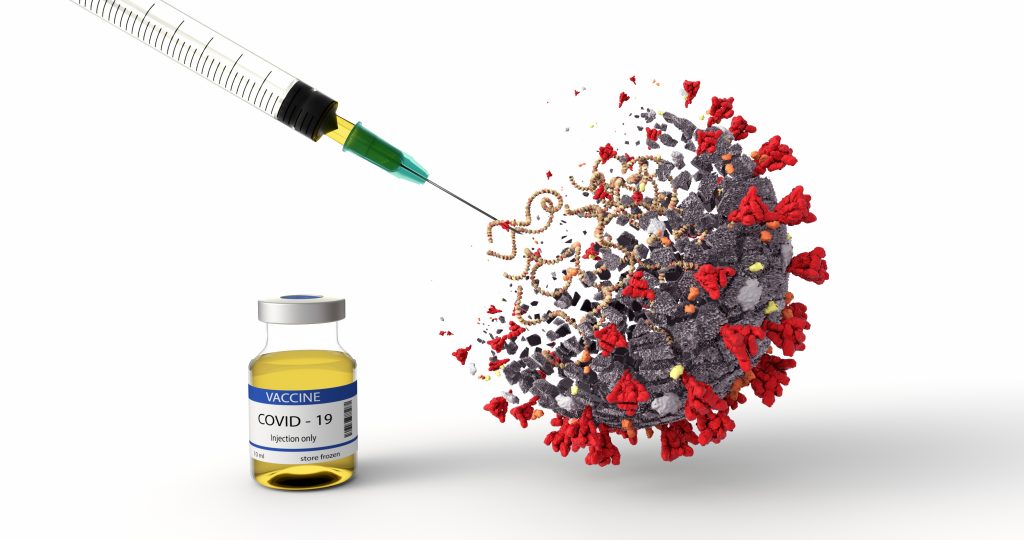On December 11, 2020, the Food and Drug Administration (FDA) gave emergency use authorization (EUA) for the Pfizer COVID-19 vaccine to be administered to people 16 years and older based on a rigorous review of data from Pfizer’s randomized controlled trial (RCT). Thus, Pfizer-BioNTech COVID-19 vaccine approval allowed Pfizer to distribute the vaccine across the country. Healthcare workers who care for patients in intensive care units and emergency departments as well as frontline employees were among the first to receive the vaccine in the U.S. On December 18, 2020, the FDA approved EUA for the COVID-19 vaccine developed by Moderna for people 18 years and older. Healthcare providers are excited about this news because these vaccines offer hope that the pandemic will be initially controlled and then stopped. The question then becomes: What must every healthcare provider, who will administer the vaccines, need to know to assure safety in administering the vaccines?
RCT Vaccine Results
The original article on the safety and efficacy of the BNT162b2 mRNA COVID-19 vaccine developed by Pfizer was published on December 10, 2020.1 The original article on the safety and immunogenicity of SARS-CoV-2 mRNA-1273, the Moderna vaccine, for use in older adults was published on December 17, 2020.2 To ensure accurate vaccine messaging to the public, all healthcare providers should read these articles or be educated on the Pfizer RCT placebo-controlled study rigor and significant outcomes. Based on RCT data analysis, the Pfizer vaccine demonstrated 95% efficacy after two doses 21 days apart. Supplemental analyses revealed efficacy among the study subgroups defined by “age, sex, race, ethnicity, obesity, and presence of a co-existing condition” (p. 9), which were consistent with the overall population studied.2 Pain at the injection site was the most commonly reported local reaction, which resolved within 1 to 2 days.
On December 18, 2020, the press release for the Moderna vaccine was published after FDA approval.3 The Moderna – COVE study – was an RCT with a 1:1 placebo-controlled study testing in 30,000 participants in the U.S., ages 18 and over with a vaccine efficacy of 94.1%. Of the 11,000 study participants, 37% were from communities of color, which is similar to the diversity of the U.S.2, 3 Similar to the Pfizer vaccine, pain at the injection site was the most commonly reported local reaction.
Provider Messaging to Vaccine Recipients: Talking to Patients and the Public
“Both Pfizer’s and Moderna’s RCTs showed clear evidence of rigorous scientific study techniques and included participants who are representative of the U.S. populations. Study safety and efficacy data are impressive. Study participants in both studies responded well to the vaccine they received after completing the two-dose series. After receiving the first dose, the body begins to develop immunity, which increases after receipt of the second dose to a very high level of immunity. I am encouraging all individuals who are not allergic to a vaccine component (which is consistent guidance for any vaccine) to accept the vaccine when available to them and their families based on the federal distribution plans. Mark your calendar for the due date of your second vaccine.”
One additional comment on messaging: I recommend that the phrase “adverse event” not be used to describe what are known as common side effects for vaccines, such as pain, erythema and/or swelling at the injection site, and other side effects identified by study participants (e.g., headache, low-grade fever, etc.). In fact, the Pfizer study uses the terms “local event” and “systemic events.” “Adverse event” should be reserved for major problems, such as an anaphylactic reaction.
To ensure public health safety, all individuals receiving the vaccine should not leave the vaccine site for 15 to 30 minutes based on their individual history. All healthcare providers also should be familiar with how to respond to an individual who is having an anaphylactic reaction (cdc.gov/vaccines/covid-19/info-by-product/pfizer/anaphylaxis-management.html).
Educating All Healthcare Providers Who Administer COVID-19 Vaccines
All healthcare providers who are preparing and/or administering the COVID-19 vaccines must be thoroughly educated on all aspects of vaccine storage, preparation, administration, patient education, and post-immunization monitoring to ensure safe administration and to immediately recognize and respond to an adverse event. Many of us who administer vaccines on a routine basis are familiar with the standard protocols and tenets of vaccine administration. However, even those with high levels of experience and expertise in all facets of vaccine storage, administration, and safety parameters must learn the specific details unique to both the Pfizer and Moderna vaccines.
The FDA published Two Fact Sheets: one for Vaccine Providers for the Pfizer vaccines (fda.gov/media/144413/download), and one for recipients and caregivers (fda.gov/media/144414/download). Likewise, the FDA published two Fact Sheets for the Moderna vaccine (fda.gov/emergency-preparedness-and-response/coronavirus-disease-2019-covid-19/moderna-covid-19-vaccine#additional ). In addition, the FDA published the FDA briefing document for the Moderna vaccine.4 It is highly recommended that anyone administering these vaccines be very familiar with the specifics of each vaccine, the storage requirements, how to draw up the vaccines, and how to administer them.
Vaccines for Pediatric, Pregnant Women, and Breast Feedings Mothers
Although Pfizer included a small number of children in their RCT who were above the age of 12 years, they reported the need to further study children, pregnant women, and breast feeding mothers before making vaccine recommendations.
References
- Polack FP, Thomas SJ, Kirchin N, et al., for the C459100 Clinical Trial Group. Safety and efficacy of the BNT162b2 mRNA COVID-19 vaccine. N Engl J Med. December 10, 2020. nejm.org/doi/full/10.1056/NEJMoa2034577
- Anderson EJ, Rouphael NG, Widge AT, et al., for the mRNA-1273 study group. Safety and immunogenicity of SARS-CoV-2 mRNA-1273 vaccine in older adults. N Engl J Med. December 17, 2020. nejm.org/doi/full/10.1056/NEJMoa2028436
- Moderna. Moderna announces FDA authorization of Moderna COVID-19 vaccine in the U.S. December 18, 2020. investors.modernatx.com/news-releases/news-release-details/moderna-announces-fda-authorization-moderna-covid-19-vaccine-us
- Food and Drug Administration. Vaccines and related biological products advisory committee meeting: FDA briefing document: Moderna COVID-19 vaccine. December 17, 2020. fda.gov/media/144434/download

